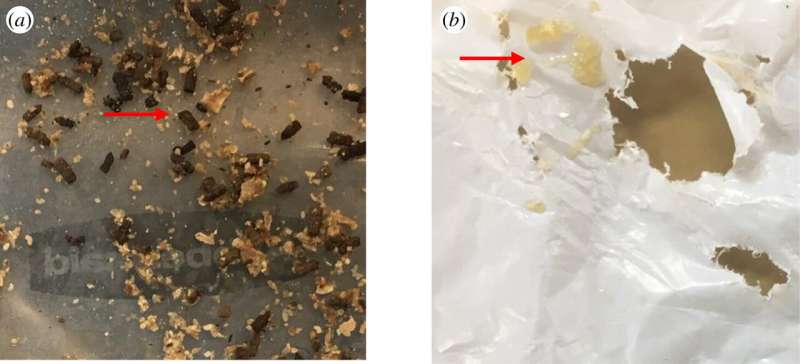March 4, 2020 report
The caterpillar larvae 'plastivores' that consume and metabolize polyethylene

A team of researchers at Brandon University has found that greater wax moth caterpillar larvae are "plastivores" that are able to consume and metabolize polyethylene. In their paper published in Proceedings of the Royal Society B, the group describes their study of the caterpillars and what they learned about them and their gut microbiome.
Prior research has shown that plastics are becoming a major pollutant. In addition to piling up in landfills, they are also broken down into microplastics, which are polluting the world's oceans. And while there have been some attempts to curb their use, they are still produced and used in abundance in many parts of the world. Thus, scientists have been searching for a way to force such materials to degrade faster—natural degradation takes approximately 100 years. In this new effort, the researchers studied wax moths and their larvae, which are known to invade beehives to eat the honeycombs inside.
The researchers with this new effort had learned of anecdotal evidence that the larvae, which exist as caterpillars, eat low-density polyethylene. To find out if this was true, they obtained multiple caterpillars and fed them a diet of plastic grocery bags. They found that 60 of the caterpillars were able to consume approximately 30 square centimeters of the plastic in a week. They also found that the caterpillars could survive for a week eating nothing but the plastic. The researchers also studied the gut microbiomes of several of the caterpillars and identified bacteria that were involved in digesting plastic. They also allowed some of the bacteria to feast on plastic outside of the caterpillar gut and found that some of them were able to survive for up to a year eating nothing but plastic. The researchers also found that there was a symbiotic relationship between the caterpillars and their gut microbiomes—the caterpillars in conjunction with their gut bacteria were able to consume more plastics than the bacteria alone.
The news was not all positive, however—the researchers also found that when the caterpillars fed on plastic, they excreted ethylene glycol, which is toxic.
More information: Bryan J. Cassone et al. Role of the intestinal microbiome in low-density polyethylene degradation by caterpillar larvae of the greater wax moth, Galleria mellonella, Proceedings of the Royal Society B: Biological Sciences (2020). DOI: 10.1098/rspb.2020.0112
Journal information: Proceedings of the Royal Society B
© 2020 Science X Network




















